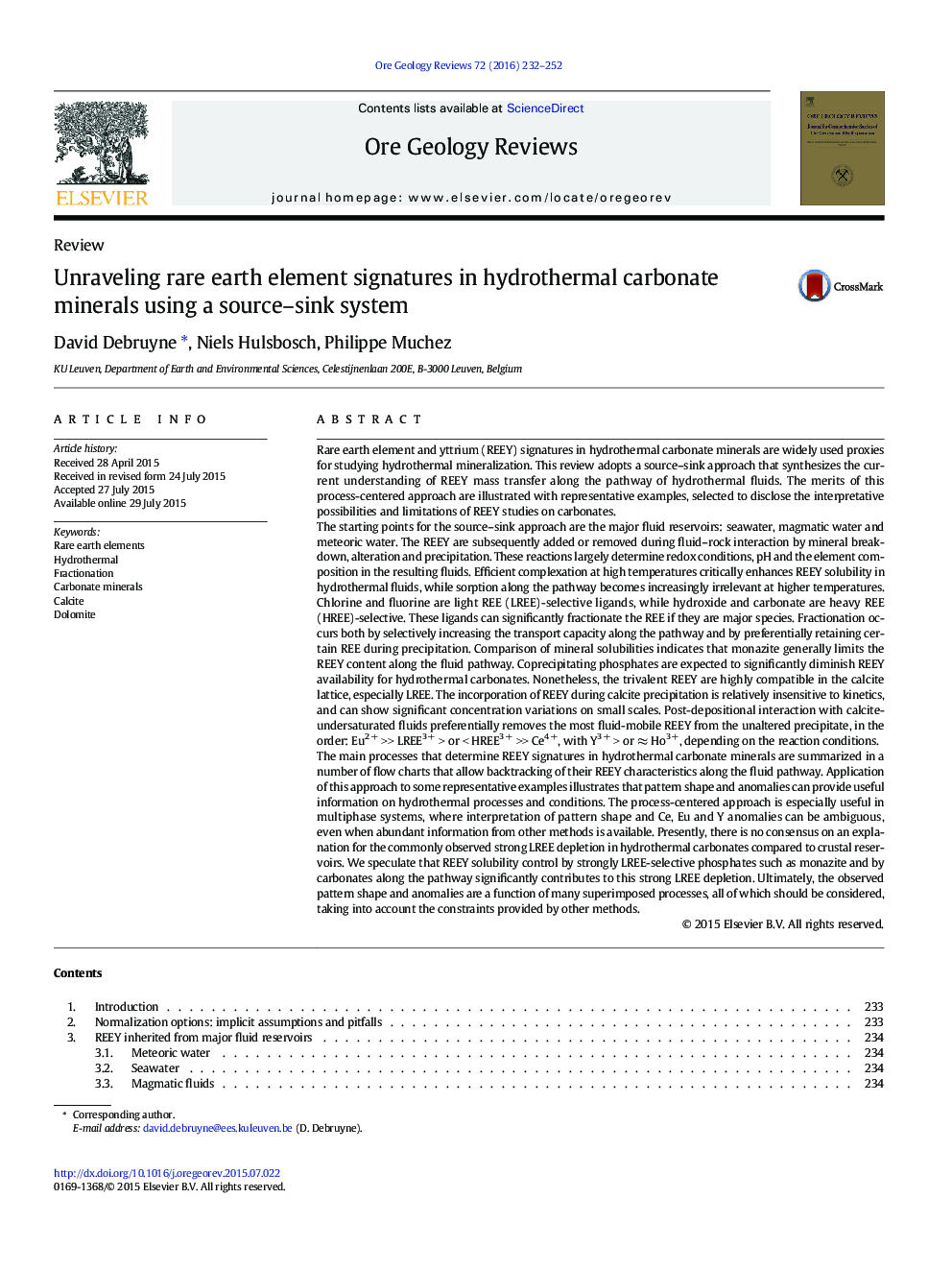| کد مقاله | کد نشریه | سال انتشار | مقاله انگلیسی | نسخه تمام متن |
|---|---|---|---|---|
| 6435846 | 1351852 | 2016 | 21 صفحه PDF | دانلود رایگان |

- Trace REEY in carbonate minerals are proven markers for hydrothermal processes.
- A source-sink system is adopted to conceptualize hydrothermal REEY mass transfer.
- The main REEY fractionating processes are summarized in flow charts.
- Examples illustrate REEY pattern 'back-tracking' along the fluid pathways.
- Rayleigh fractionation of carbonate minerals could strongly influence REEY.
Rare earth element and yttrium (REEY) signatures in hydrothermal carbonate minerals are widely used proxies for studying hydrothermal mineralization. This review adopts a source-sink approach that synthesizes the current understanding of REEY mass transfer along the pathway of hydrothermal fluids. The merits of this process-centered approach are illustrated with representative examples, selected to disclose the interpretative possibilities and limitations of REEY studies on carbonates.The starting points for the source-sink approach are the major fluid reservoirs: seawater, magmatic water and meteoric water. The REEY are subsequently added or removed during fluid-rock interaction by mineral breakdown, alteration and precipitation. These reactions largely determine redox conditions, pH and the element composition in the resulting fluids. Efficient complexation at high temperatures critically enhances REEY solubility in hydrothermal fluids, while sorption along the pathway becomes increasingly irrelevant at higher temperatures. Chlorine and fluorine are light REE (LREE)-selective ligands, while hydroxide and carbonate are heavy REE (HREE)-selective. These ligands can significantly fractionate the REE if they are major species. Fractionation occurs both by selectively increasing the transport capacity along the pathway and by preferentially retaining certain REE during precipitation. Comparison of mineral solubilities indicates that monazite generally limits the REEY content along the fluid pathway. Coprecipitating phosphates are expected to significantly diminish REEY availability for hydrothermal carbonates. Nonetheless, the trivalent REEY are highly compatible in the calcite lattice, especially LREE. The incorporation of REEY during calcite precipitation is relatively insensitive to kinetics, and can show significant concentration variations on small scales. Post-depositional interaction with calcite-undersaturated fluids preferentially removes the most fluid-mobile REEY from the unaltered precipitate, in the order: Eu2 + >> LREE3 + > or < HREE3 + >> Ce4 +, with Y3 + > or â Ho3 +, depending on the reaction conditions.The main processes that determine REEY signatures in hydrothermal carbonate minerals are summarized in a number of flow charts that allow backtracking of their REEY characteristics along the fluid pathway. Application of this approach to some representative examples illustrates that pattern shape and anomalies can provide useful information on hydrothermal processes and conditions. The process-centered approach is especially useful in multiphase systems, where interpretation of pattern shape and Ce, Eu and Y anomalies can be ambiguous, even when abundant information from other methods is available. Presently, there is no consensus on an explanation for the commonly observed strong LREE depletion in hydrothermal carbonates compared to crustal reservoirs. We speculate that REEY solubility control by strongly LREE-selective phosphates such as monazite and by carbonates along the pathway significantly contributes to this strong LREE depletion. Ultimately, the observed pattern shape and anomalies are a function of many superimposed processes, all of which should be considered, taking into account the constraints provided by other methods.
Journal: Ore Geology Reviews - Volume 72, Part 1, January 2016, Pages 232-252